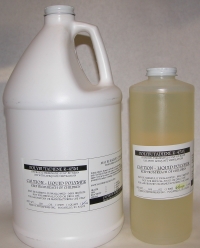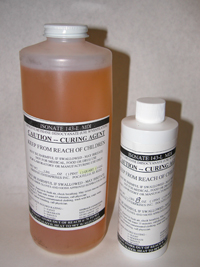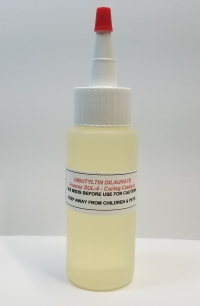
FOMREZ SUL-4, dibutyltin dilaurate
highspeed catalyst - Stock #C146B
Use one drop per pound of HTPB resin composite mixture to speed cure time.
SILICONE FLUID
- (polydimethylsiloxane or PDMS) - Stock #C180SF
Release & anti-foam agent in composite propellants and similar mixtures. 2 drops per 5 lb batch is all that is required, added to the polymer first. Thinly coated on surfaces as a mold release agent.
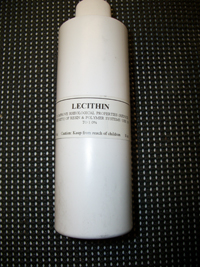
LECITHIN
- propellant processing aid, viscosity reducer - Stock #C1571
.75-1% added to composite propellants to reduce viscosity for mixing.
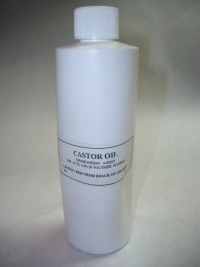
CASTOR OIL
- ricinoleic acid, chainlinking agent - Stock #C1271
Used in composite formulations using Polybutadienes and polyesters to chemically chainlink (structurally bond) the composite matrix. Only a few drops required. Goes a long way.
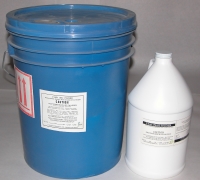
PBAN POLYMER
- polybutadiene/acrylic acid - Stock #C164
Composite polymer (CTPB) using DER-331 epoxy to cure. This one is used as the
binder to make the Space shuttle SRB propellant. Very popular and practically
foolproof, taking longer to cure than R-45, the cure temps range from 150° - 200° F. Takes approx 4-7 days @ 180° F. The higher the cure temp, the faster it will cure, as with all CTPB systems. Literature using PBAN is in our literature section "Composite Color Flames" by Gary Purrington. Can also be used to make insect sticky paper and hanging strips. Simply paint a thin layer on cardstock or ribbon. Requires no curative for this. Does not dry out - Works Great!
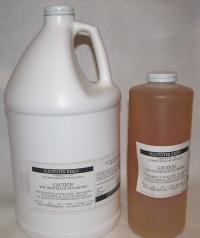
POLYESTER RESIN - FORMREZ F17-80
- viscous liquid, propellant grade - Stock #C165
CTPB cures with DER-331 epoxy. Cure accelerators include Dabco TMR-5, Iron Linoleate and other metal catalysts. Composite flare: 14% F17-80, 3% DER-331, 46% Sodium Nitrate, 37% coated Magnesium such as inexpensive floor sweepings, stock #C157FS. Cure @ 180F. 1.0 to 1.5% Dabco TMR-5 will help speed curing.
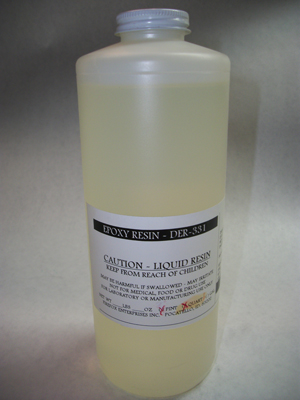
POXY RESIN DER-331 Bisphenol A/Epichlorohydrin
- Stock #C1462 Out of stock
Mix 50/50 with Versamid 140 or Versamid 253 for a room temp epoxy cure.(or as per instructions using other epoxy curatives). Also used as a curative for PBAN, F17-80 polyester resin & HC434 (all CTPB) resins.
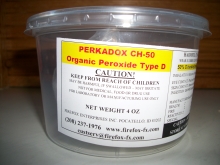
CURING AGENT - PERKADOX CH-50,
- dibenzoyl peroxide, 50% with dicyclohexyl phthalate. Stock # C144/CH50
A white/off white powder curative used as a polymerization initiator for plastics and resins. It is added in quantities of .5 to 5% to cure resins such as styrenes, polyesters (including thermoset resins), vinyl acetate, acrylonitrile, acryl esters, diallyl phthalate and other similar resins and/or combinations thereof. It is also used as an alternative for the more hazardous methyl ethyl ketone peroxide (MEKP). Heat and/or Perkadox 14S-FL (listed below) is applied to increase the (cure) rate of polymerization. Powder replacement for the more hazardous, hard to get Methyl Ethyl Ketone Peroxide
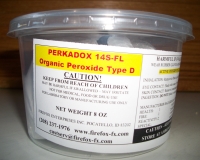
CURING / CROSSLINKING AGENT - PERKADOX 14S-FL,
Stock # C144/14S
Perkadox 14S-FL is used as a crosslinking agent/polymerization initiator for plastics. Added in the amounts of .5 to 1%, to fortify the chemical bond of the cured resins such as styrenes, polyesters (including thermoset resins), vinyl acetate, acrylonitrile, acryl esters, diallyl phthalate and other similar resins and/or combinations thereof. Heat may also be supplied to increase the rate of polymerization. Used with Perkadox CH-50 and many other curatives.
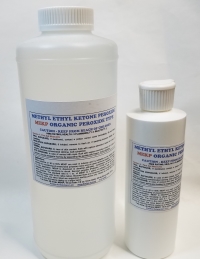
CURING AGENT METHYL ETHYL KETONE PEROXIDE (MEKP) 35-40% in Dimethyl Phthalate
liquid curing agent - Stock #CMEKP
Wikipedia; Concentrated Methyl Ethyl Ketone Peroxide (MEKP) is an organic peroxide, a high explosive similar to acetone peroxide. MEKP is a colorless, oily liquid whereas acetone peroxide is a white powder at STP; MEKP is slightly less sensitive to shock and temperature, and more stable in storage. MEKP is a severe skin irritant and can cause progressive corrosive damage or blindness. Dilute solutions of 30 to 60% MEKP are used in industry and by hobbyists as the catalyst which initiates the crosslinking of unsaturated polyester resins used in glass-reinforced plastics, and casting. For this application, MEKP is dissolved in dimethyl phthalate, cyclohexane peroxide, or diallyl phthalate to reduce sensitivity to shock. Benzoyl peroxide (Perkadox CH-50) can be used for the same purpose. The standard ratio is 1 oz. of MEKP to 1 gallon of polyester resin. For smaller quantities, please refer to the ratios below. Because there are numerous factors that govern the cure rate of the resin, the ratios listed are suggested starting points only. Always do a test with a small amount of resin first before mixing up a larger batch.
1 oz resin: 20 drops MEKP
16 oz resin: 1/8 oz MEKP
32 oz resin: 1/4 oz MEKP
64 oz resin: 1/2 oz MEKP
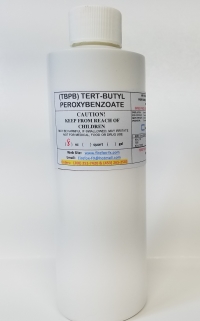
CURING / CROSSLINKING AGENT - TERT-BUTYL PEROXYBENZOATE (TBPB),
(Tert-Butyl Benzenecarboperoxide), liquid [C11H14O3] Stock # CTBPB
TBPB is a clear, semi-clear liquid with an oxidizer content of 8% used for the polymerization or co-polymerization of a variety of polymers and plastics. It has a density @ 20°C of 1040 kg/m3, and a viscosity @ 20°C of 6 mPa.s. Applications (taken from Tianjin McEit website)
- Polymerization of styrene; TBPB can be used for the polymerization and copolymerization of styrene in the temperature range of 100-140°C. During polymerization the temperature is increased in steps.
- Polymerization of acrylates and methacrylates; TBPB can be used as initiator for the solution (co)polymerization of acrylates and methacrylates in the temperatures range of 100-170°C, amongst others for the coatings. TBPB can also be applied as an initiator for the bulk and suspension (co)polymerization of acrylates and methacrylates.
-
Polymerization of ethylene; TBPB is an efficient initiator for the ethylene polymerization under high pressure in both autoclave and tubular processes.To obtain a wide spectrum of polymerization temperatures, combinations with other peroxides are applied in practice. Depending on reaction conditions. TBPB is active in the temperature range of 220-270°C.
-
Other applications; TBPB can also be used for the (co)polymerization of acrylonitrile and vinyl acetate.
-
Crosslinking Peroxides; TBPB, is suitable for crosslinking of EPDM rubber compounds at ambient temperature within some weeks. Rubber compounds containing TBPB have moderate processing safety in combination with a very high speed of cure.
- Peroxides for Thermoset Resins; TBPB, tert-butyl peroxybenzoate, is an aromatic perester, which is used for the curing of unsaturated polyester resins at elevated temperatures. TBPB is preferred for the curing of UP resin based Hot Press Moulding formulations (SMC, BMC, ZMC etc) in the temperature range of 120 - 170°C.
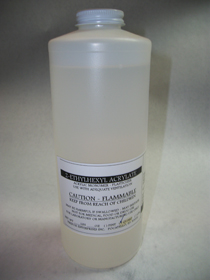
2-ETHYL HEXYL ACRALATE (EHA), Acrylic acid ester, [CH2=CHCOOC8H17] Acrylic monomer and plasticizer
- Stock #C1463
Synonyms; Acrylic acid, 2-ethylhexy ester; Octyl Acrylate; 2-Propenoic acid, 2-ethylhexy ester; 1-Hexanol, 2-ethyl-, acrylate; 2-ethylhexyl 2-propenoate; 2-Ethylhexyl 2-propenoate; 2-Ethylhexanol acrylate; 2-Ethyl-1-hexyl acrylate; 2-Propenoic acid octyl ester; EHA; Ethyl hexyl acrylate; Octyl acrylate. Acrylic acid is the simplest unsaturated carboxylic acid which has double bond and carboxyl group in C3 one molecule with the formula CH2=CHCOOH. The vinyl group is attached to the carbonyl carbon directly. The systemic name is 2-propenoic acid. Acrylic acid has two reaction points or functional groups required for polymerization process. Purified (glacial) acrylic acid is a clear, colorless liquid with a characteristic acrid odor (Acidity (pKa) 4.35). It is miscible with water, but soluble in ether and alcohol. Acrylic acid undergoes the typical reactions of a carboxylic acid and forms acrylic esters - basic alkyl esters are methyl, butyl, ethyl acrylate, and 2-ethylhexyl acrylate. Acrylic acid and its esters undergo the reactions of the double bond which readily combine with themselves or other monomers (e.g with methacrylates, acrylonitrile, maleic acid esters, vinyl acetate, vinyl chloride, vinylidene chloride, styrene, butadiene, unsaturated polyesters and drying oils, etc.) to form homopolymers or co-polymers which are used in the production of propellant binders/elastomers, coatings, adhesives, caulks, elastomers, super absorbent polymers, flocculants, as well as fibres and plastics. Acrylate polymers show a wide range of properties dependent on the type of the monomers and reaction conditions. Due to its low volatile nature plus reactivity of double bonds, it is also the perfect choice for plasticising many applications. Commonly used with a monomer containing reactive cure sites selected from the group consisting of hydroxyl groups (HTPB), glycidyl groups, carboxylic acid groups (CTPB), and unsaturated cure sites is incorporated into a rubbery polymer (R-45 polybutadiene/HTPB, PBAN/CTPB, Polyester F17-80/CTPB and HC434 resins/CTPB). Special Sale Priced............
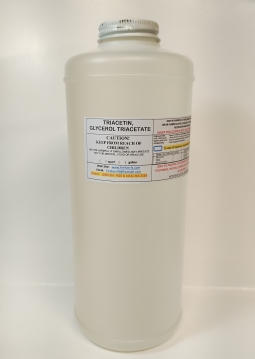
TRIACETIN,
(glycerol triacetate) - Stock #C198E
Plasticizer/elastomer, very rubbery cures . Used extensively in propellants and explosives.
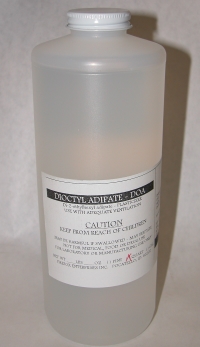
DIOCTYL ADIPATE
(DOA) - liquid plasticizer/elastomer - Stock #C1461
Most commonly used plasticizer in composite rocket propellants and other pyrotechnic composites.
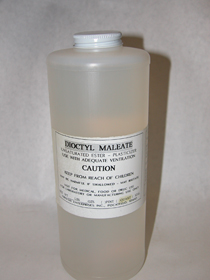
DIOCTYL MALEATE
(DOM) - liquid plasticizer/elastomer - Stock #C1461A
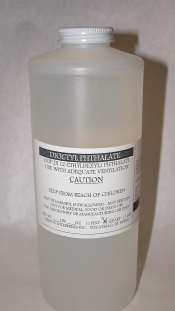
DIOCTYL PHTHALATE
(DOP) liquidplasticizer/elastomer - Stock#C1461A1
DIOCTYL SEBACATE
(DOS) - liquid plasticizer/elastomer - Stock #C1461B

MINERAL/FOG OIL
- paraffin oil, fog oil - Stock #SMKFOG
Used as a protective coating agent and binder in flare formulations. It is also used extensively as a fog oil, where it is heat vaporized into white "fog". U.S. Military Surplus.

PROPYLENE GLYCOL, Theater Fog Oil
- [C3H8O2]; 1,2-propanediol, propane-1,2-diol, a-propylene glycol; - Stock # C175PG Out of stock
Propylene glycol is a non-toxic, colorless, nearly odorless, clear, viscous liquid with a faintly sweet taste. It is hygroscopic and miscible with water, acetone, ethanol, diethyl ether and chloroform. It is the main ingredient in products such as fog oil for theatrical fog machines and insecticidal smoke fog oil. It can also be used in pyrotechnic smoke mixtures (especially color smoke mixtures) to prevent dyes from "dusting" into the air and provide more smoke density in combustion, and as a dampening agent to control airborn dusts while mixing. Other uses include; mixing with wax and gelatin in the manufacture of paintballs, as a wetting agent to control drying times of paints and lacquers, as a non-toxic antifreeze for winterizing drinking water systems in campers and motor homes, septic systems, etc., to de-ice aircraft and airstrips, as a moisturizer in foodstuffs, medicines, cosmetics, etc...

